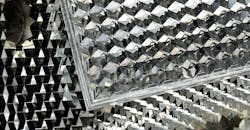The expanding applications for pressure diecasting has brought an increased level of attention to how such operations perform, and what might be done to enhance performance or improve productivity.
Researchers at Germany’s Fraunhofer Institute for Manufacturing Technology and Advanced Materials have partnered with others to develop a cold-plasma process for applying a gradient layer coating to tool steel, stainless steel, or aluminum mold/die faces. They report that the UltraPlas coating makes it possible to standardize very high quality results “even for nano-scaled and reflective surfaces.”
The project began with an inquiry to the possibilities for coating mold surfaces in a way that would improve the forming process and also simplify mold cleaning after forming. The Fraunhofer IFAM team joined their effort to the work of two government-funded programs – GlossyCast and UltraTrenn. The coordinated goal was to reduce demolding forces and the formation of deposits on the mold surface, while weathering the specific stresses of zinc high-pressure diecasting and plastic injection molding processes.
As IFAM explained, injection molding of advanced plastic parts demands solutions that will simplify demolding (“reduce demolding forces) and also minimize deposits on the mold faces, which impacts the finish quality of parts with high-gloss surfaces or highly defined microstructures – for example, plastic lenses, decorative trims, or connectors with high dimensional accuracy.
Similarly, zinc diecastings sometimes leave deposits on mold surfaces. And residues from release agents and lubricants can degrade the surface quality of zinc diecastings, which incurs pos-production costs.
Notwithstanding those additional costs, cleaning release agents from mold surfaces may account for as much up to 20% of the diecasting cycle time, which IFAM cited as the opportunity for additional process and material cost savings.
IFAM’s proposed new process is called UltraPlas: to produce finished parts with “ultra-smooth” (Ra < 25 nm) surfaces, the coating must be smooth and “structureless,” it states. A cold plasma process called PE-CVD (plasma enhanced chemical vapor deposition) was adopted. By building up a gradient layer, this process makes it possible to establish very consistent layer adhesion to the mold surface but also excellent non-stick properties with premium-quality physical characteristics on the cast product.
The coating has a high modulus of elasticity (28 - 32 GPa) and a high density (1.5 g/cm³), resulting in a Mohs hardness range of 5.5, comparable with glass or enamel. It also has a low surface energy (< 28 mN/m) with low polarity (< 1.5 mN/m).
Fraunhofer researchers succeeded in producing the UltraPlas coating with a particularly thin layer thickness, less than 100 nm. The thin, structureless layers allow both nanoscale surface structures and “mirror-gloss” surfaces to be reproduced, according to IFAM.
Industrial testing carried out as part of the projects revealed that demolding forces and residue formation are reduced for injection molding, and the reduction in adhesion forces reduces the total demolding forces. As a result, the demolding temperature can be increased, and the amount of friction reduced.
Also, the coatings can be removed both effectively and gently using plasma technology so that a new coating can be applied several times without any loss of quality. This is notable for high-gloss tool surfaces, as it eliminates the need for polishing or precision machining.
Tests also show that production of high-quality zinc diecast surfaces can be achieved with greater efficiency: By significantly improving the surface quality of the castings, costly and time-consuming post-processing (e.g., blasting, grinding, polishing) can be simplified or avoided. And the individual process steps of electroplating can be shortened or reduced.
According to IFAM, the development of UltraPlas release coating for zinc diecasting is a significant advance in metalcasting technology, raising the potential for higher-quality cast parts with lower production costs and better environmental impact. As the cast products are manufactured without release agents, pre-treatment time for electroplating is reduced, as is material consumption.
The manufactured components deliver the desired roughness, and due to a smoother surface, bright copper plating can be avoided, which saves materials, time, and wastewater.
About the Author
Robert Brooks
Content Director
Robert Brooks has been a business-to-business reporter, writer, editor, and columnist for more than 20 years, specializing in the primary metal and basic manufacturing industries. His work has covered a wide range of topics, including process technology, resource development, material selection, product design, workforce development, and industrial market strategies, among others.
